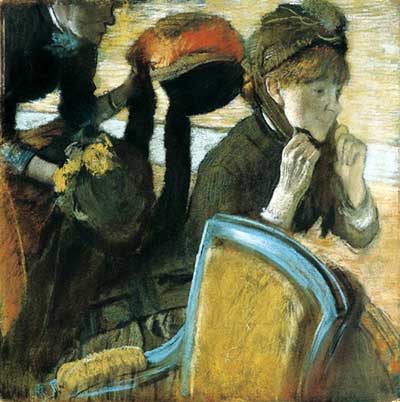Edgar Degas Gallery
This cameo of nineteenth-century life maintains its intimacy through Degas's use of pastel, whose chalky texture quiets the scene in multiple veils of color. Pastel, an important drawing medium at the end of the nineteenth century due in part to a new preoccupation with color, appropriately expresses, through its inherent fragility, the ephemeral encounter between two women of different milieus that lies at the heart of Degas's composition.
Degas often accompanied his female friends to the dressmaker's and the milliner's. Here, one of them, the American artist Mary Cassatt, serves as the model and tries on hats while an attendant waits expectantly behind her. Cassatt's expression of contented self-assurance contrasts sharply with the apprehensive posture of the shopgirl, a figure obscured by cropping and the lack of delineation of her facial features.
In this daring nuanced composition about modern life—the subject is the fleeting encounter rather than the women themselves—Degas heeded the advice of the critic Edmond Duranty, who, in his 1876 pamphlet, The New Painting—about the art that came to be known as Impressionism—wrote: "Let us take leave of the stylized human body, which is treated like a vase. What we need is the characteristic modern person in his clothes, in the midst of his social surroundings, at home or out in the street."

viewer |
|
|
| Self-Portrait |
| Millinery Shop |
| Interior with Two Figures |
| After the Bath |
| Toilet of a Woman |
| Race Horses |
Milliners |
Biography
Bulletin Board
Renowned Art
(home)
Degas was born and died in Paris. He is buried at the cemetery of Montmartre. He entered the École des Beaux-Arts and visited Rome and Florence. From 1865 to 1870 he exhibited each year at the Paris Salon. He also exhibited with the Impressionists. Degas assimilated into his mature style English art and Japanese prints. He acquired his enduring reputation as a "painter of dancers" and also painted the café-concert, laundry women, bathers, jockeys and milliners. From the mid-1870's he worked with pastels. He was also a gifted sculptur. He struggled with failing vision and blindness at the end of his life.
all artists, with thumbnails: by birth year | alphabetically
all artists: by birth year | alphabetically
artists born in the 13th 14th 15th 16th 17th 18th 19th 20th century